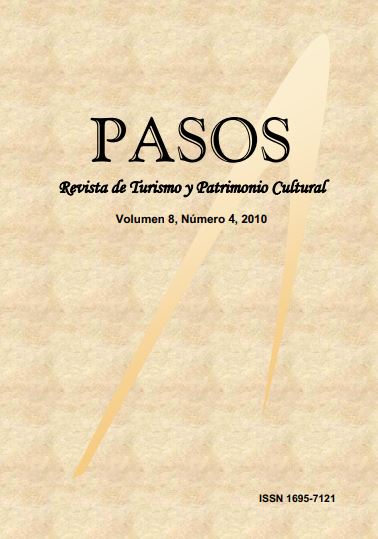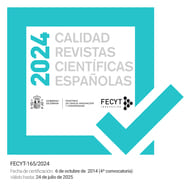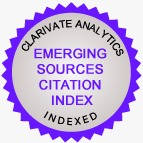Modelo de pesquisa da gestão ambiental em empresas hoteleiras
DOI:
https://doi.org/10.25145/j.pasos.2010.08.042Palavras-chave:
protecção ambiental, empresarial, modelo de investigação, desempenhoResumo
O trabalho atual visa desenvolver um instrumento para medir o impacto das empresas’ atividades de proteção ambiental- mental em seu desempenho econômico. Este instrumento destina-se especificamente ao sector do turismo, que raramente é analisado nesta perspectiva, apesar da sua considerável relevância devido à sua forte interacção com o ambiente. O trabalho testa empiricamente o modelo em uma amostra de hotéis nas Ilhas Canárias (Espanha). Utiliza a modelagem de equações estruturais para analisar a informação. Os resultados mostram que o modelo proposto se encaixa bem na realidade subjacente, e seus componentes constituintes satisfazem critérios de validade e confiabilidade. Deste modo, contribuem significativamente para o conhecimento dos determinantes e implicações da sustentabilidade nas empresas do sector do turismo.Downloads
##plugins.generic.pfl.publicationFactsTitle##
##plugins.generic.pfl.reviewerProfiles## Indisp.
##plugins.generic.pfl.authorStatements##
##plugins.generic.pfl.indexedIn##
-
##plugins.generic.pfl.indexedList##
- ##plugins.generic.pfl.academicSociety##
- PASOS. Revista de Turismo y Patrimonio Cultural
- ##plugins.generic.pfl.publisher##
- Instituto Universitario de Investigación Social y Turismo. Universidad de La Laguna (España) - Instituto Universitario da Maia ISMAI (Portugal)
Referências
Álvarez, M.J.; Burgos, J.; Céspedes, J. 2001 “An analysis of environmental management, organizational context and performance of Spanish hotels”. Omega, 29 (6): 457-71
Aragón-Correa, J.A. 1998 “Strategic Proactivity and firm approach to the natural environment”. Academy of Management Journal, 41(5): 556-567
Azzone, G.; Manzini, R. 1994 “Measuring strategic environmental performance”. Business Satrategy and the Environment, 3(1): 1-14
Barbera, A.J.; McConnell, D. 1990 “The impact of environmental regulations on industry productivity: direct and indirect effects”. Journal of Environmental Economics and Management, 18(1): 50-65
Bowen, F.E. 2000 “Environmental visibility: a trigger of green organizational response?. Business Strategy and the Environment, 9(2): 92-107
Boyd, B. 1991 “Strategic planning and financial performance: a meta-analytic review”. Journal of Management Studies, 28:353-374
Burgos, J.; Céspedes, J.J. 2001 “La protección ambiental y el resultado. Un análisis crítico de su relación”. Investigaciones Europeas de Dirección y Economía de la Empresa, 7(2): 93-108
Christmann, P. 2000 “Effects of ‘best practices’ of environmental management on cost advantage the role of comple-mentary assets”. Academy of Management Journal, 43(4): 663-680
Churchill, G.A. 1979 “A paradigm for developing better measures of marketing constructs”. Journal of Marketing Re-search, 16: 64- 73
Claver, E.; López, M.D.; Molina, J.F.; Tarí, J.J. 2004 “The relationship between environ-
mental management and firm performance: a case study”. Paper presented at the Gronen Workshop, 21st – 23rd of April; Granada (Spain)
Cordeiro, J.J.; Sarkis, J. 1997 “Environmental proactivism and firm performance: evidence from security analyst earning fore-cast”. Business Strategy and the Environment, 6(2): 104-114
Cramer, J. 1998 “Environmental management: from fit’ to ‘strech’”. Business Strategy and´the Environment, 7(3): 162-172
Flannery, B.L.; May, D.R. 2000 “Environmental ethical decision making in the U.S. Metal-Finishing Industry”. The Academy of Management Journal, 43(4): 642-662
Foster, S.T.; Sampson, S.E. y Dunn, S.C. 2000 “The impact of customer contact on environmental initiatives for service firms”. International Journal of Operations and Production Management, 20(2): 187-203
Global Reporting Initiative (GRI) 2002 Guide for the elaboration of Memories of Sustainability on the economic, environmental and social performance of the company; available in http://www.global-reporting.org/guidelines
González-Benito, J.; González-Benito, O. 2005 “Environmental Proactivity and Business Performance: an empirical analysis”. Omega, 33(1): 1-15
González, M.; León, C. (2001): “The adoption of environmental innovations in the hotel industry of Gran Canaria”; Tourism Economics, 7(2): 177-190
Greenberg, R.; Unger, C. 1992 “Performance indicators of environmental processes”. Total Quality Environmental Management, summer, 1(4): 405-408
Greeno, J.L. 1994 “Corporate environmental excellence and stewardship”, in: Kolluru, R. (ed.) Environmental strategies handbook: a guide to effective policies & practices; Mc Graw Hill; New York
Hair, J.F., Anderson, R.E., Tatham, R.L., Black, W.C. 1999 Multivariate Data Analysis, 5th (ed) Prentice Hall Int Handfield, R.B.; Walton, S.V.; Seegers, L.K.; y Melnyk, S.A. 1997 “«Green» value chain practices in the furniture industry”. Journal of Operations Management, 15(3): 293-315
Hart, S.L. 1995 “A natural-resource-based view of the firm”. Academy of Management Review, 20(4): 986-1014
Hart, S.L.; Ahuja, G. 1996 “Does it pay to be green? An empirical examination of the relationship between emission reduction and firm performance”. Business Strategy and the Environment, 5(1): 30-37
Henriques, I., Sadorsky, P. 1996 “The determinants of environmentally responsive firm: an empirical approach”. Journal of Environmental Economics and Management, 30: 381-395
Henriques, I.; Sadorsky, P. 1999 “The relationship between environmental commitment and managerial perceptions of stakeholder importance”. Academy of Management Review, 42(1): 87-99
Hunt, C.B.; Auster, E.R. 1990 “Proactive environmental management: avoiding the toxic trap”. Sloan Management Review, (win-ter) 31(2): 7-18
Hunter, C.; Green, H. 1995 Tourism and the Environment. A sustainable relationship?; Routledge; London and New York
IHEI (International Hotels Environmental Initiative) 1993 Environmental Management for Hotels; Butterworth-Heinemann; Oxford
Ilinitch, A.Y.; Soderstrom, N.S.; Thomas, T.E. 1998 “Measuring corporate environmental performance”. Journal of Accounting and Public Policy, 17: 383-408
James, P. 1994 “Business environmental performance measurement”. Business Strategy and the Environment, 3(2): 59-67
Jöreskog, K., Sörbon, D. 1993 LISREL 8 Structural Equations Modelling with the SIMPLIS Command Language. Mooresville: Scientific Software International Judge, W.Q., Douglas, T.J. 1998 “Performance implications of incorporating natural environmental issues into the strategic planning process: an empirical assessment”. Journal of Management Studies, 35(2): 241-262
King, A.; Lenox, M.J. 2002 “Exploring the Locus on Profitable Pollution Reduction”. Management Science, 48(2), 289-299
Kirk, D. 1995 “Environmental management in hotels”. International Journal of Contemporary Hospitality Management, 7(6): 3-8
Kirk, D. 1998 “Attitudes to environmental management held by a group of hotel managers in Edinburgh”. Hospitality Management, 17:33-47
Klassen, R.D.; McLaughlin, C.P. 1996 “The impact of Environmental Management on Firm Performance”. Management Science, 42(8):1199-1214
Klassen, R.D., Whybark, D.C. 1999 “Environmental management in operations: the selection of environmental technologies”. Decision Sciences; 30(3): 601-631
Kleiner, A.1991 “What does it mean to be green?”. Harvard Business Review, July-August, 38-47
Kolk, A.; Mauser, A. 2002 “The evolution of environmental management: from stage models to performance evaluation”. Business Strategy and the Environment, 11(1): 14-31
Lober, D.J. 1996 “Evaluating the environmental performance of corporations”. Journal of Managerial Issues, 8(2): 184-205
Macauley, D. 1999 “Responding to Stakeholders”. In: Piasecki, B.W., Fletcher, K.A.; Mendelson, F.J., Environmental Management And Business Strategy. Leadership Skills for the 21st Century; John Wiley and Sons; New York
Mendelson, F.; Piasecki, B. 1999 “The public face of corporate environmental strategy”. In Piasecki, B.W., Fletcher, K.A.; Mendel-son, F.J., Environmental Management And Business Strategy. Leadership Skills for the 21st Century; John Wiley and Sons; New York
Miller, C.; Cardinal, L.B. 1994 “Strategic planning and firm performance: a synthesis of more than two decades of research”. Academy of Management Journal, 37: 1649-1665
Nehrt, C. 1996 “Timing and intensity effects of environmental investments”. Strategic Management Journal, 17(7): 535-547
North, K. 1992 Environmental Business Management: an introduction; International Labour Organisation; Ginebra
Peattie, K.; Ringler, A. 1994 “Management and the environment in the United Kingdom and Germany: A comparison”. Euro-pean Management Journal, 12(2): 216-225
Porter, M.E. and Van der Linde, C. 1995 “Green and Competitive: Ending the stalemate”. Harvard Business Review, 73(5): 120-134
Powell, T. 1995 “Total quality management as competitive advantage: a review and empirical study”. Strategic Management Journal, 16: 15-37
Russo, M.V.; Fouts, P.A. 1997 “A Resource-based Perspective on Corporate Environmental Performance and Profitability”. Academy of Management Journal, 40(3): 534-559
Schmidheiny, S. 1992 Cambiando el rumbo. Una perspectiva global del empresariado para el desarrollo y el medio ambiente; Fondo de Cultura Económica; México
Sharma, S. 2000 “Managerial Interpretations and Organizational Context as Predictors of Corporate Choice of Environmental Strategy”. Academy of Management Journal, 43(4): 681-697
Sharma, S.; Vredenburg, H. 1998 ”Proactive corporate environmental strategy and the development of competitively valuable organizational capabilities”. Strategic Management Journal, 19(8): 729-753
Skalpe, O.; Sandvik, K. 2002 “The economics of quality in the hotel business”. Tourism Economics, 8(4): 361-376
Starik, M.; Marcus, A. 2000 “Special research forum on the management of organization in the natural environment: a field emerging from multiple paths, with many challenges ahead”. Academy of Management Journal, 43(4): 539-546
Tilt, C.A. 1997 “Environmental policies of major companies: Australian evidence”. British Accounting Review, 29: 367-394
Tyteca, D. 1996 “On the measurement of the environmental performance of the firms – a literature review and productive efficiency perspective”. Journal of Environmental Management, 46(3): 281-308
Tyteca, D.; Carlens, J.; Berkhout, F.; Hertin, J.; Wehrmeyer, W. y Wagner, M. 2002 “Corporate environmental performance evaluation”. Business Strategy and the Environment, 11(1): 1-13
Ullman, J. 1985 “Data in search of a theory: a critical examination of the relationship among social performance, social disclosure and economic performance of U.S. firms”. Academy of Management Review, 10(3): 540-557
Wagner, M. 2001 A review of empirical studies concerning the relationship between environmental and economic performance. What does the evidence tell us?; Center for Sustainability Management e.v., Universität Lüneburg; Lüneburg
Walley, N.; Whitehead, B. 1994 “It´s not easy being green”. Harvard Deusto Business Review, 72(3): 46-52
Welford, R.1995 Environmental strategy and sustainable development. The corporate challenge for the 21st century; Routledge; London & New York
Welford, R.; Gouldson, A. 1993 Environmental management and business strategy; Pitman Publishing; London
Wight, P. 1994 “The greening of the hospitality industry: economic and environmental good sense”. In Seaton, A.V.; Jenkins, C.L.; Wood, R.C.; Pieke, P.U.C.; Bennet, M.M.; McLellan, L.R.; Smith, R. (ed.) Tourism: the state of the art; John Willey and Sons; Chichester; 665-674
Williams, H.E.; Medhurst, J.; Drew, K. 1993 “Corporate strategies for a sustainable future”. In Fischer, K.; Schot, J. (ed.): Environmental strate-gies for industry: International perspectives on research needs and policy implications; Island Press; Washington D.C.; 117-146
Wolters, T.; James, P.; Bouman, M. 1997 “Stepping-stones for integrated chain management in the firms”. Business Strategy and the Environment, 6(3):121-132
Worrell, D.; Gilley, K.M.; Davidson III, W.D.; El-Jely, A. 1995 “When green turns to red: stock market reaction to announced greening activities”. Paper presented at the Academy of Management Meeting; Vancouver.
Downloads
Publicado
Como Citar
Edição
Seção
Licença
Confirmo que o trabalho é original (de minha/nossa autoria), e que não será submetido a outras revistas ou publicações até a resolução final do processo de revisão em PASOS, RTPC.
Autorizo a publicação do meu trabalho por PASOS, PSTN de acesso livre e aberto em qualquer dos formatos que considere oportuno, por tempo indeterminado e como colaboração não remunerada.
Da mesma forma, o(s) autor(es) entende(m) que o trabalho publicado pode ser vinculado ou depositado em qualquer servidor ou incluído em outras publicações (republicação), desde que o novo local e/ou a nova edição façam referência à publicação original e reconheçam a autoria e propriedade de direitos autorais das publicações PASOS RTPC.
Os autores entendem que uma verificação de plágio autoplágio será realizada, e o artigo poderá ser removido a qualquer momento do fluxo editorial.










